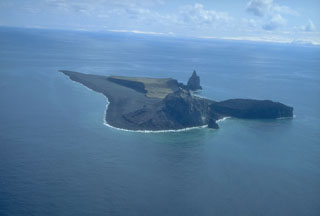Report on Bogoslof (United States) — 5 July-11 July 2017
Smithsonian Institution / US Geological Survey
Weekly Volcanic Activity Report, 5 July-11 July 2017
Managing Editor: Sally Sennert.
Please cite this report as:
Global Volcanism Program, 2017. Report on Bogoslof (United States) (Sennert, S, ed.). Weekly Volcanic Activity Report, 5 July-11 July 2017. Smithsonian Institution and US Geological Survey.
Bogoslof
United States
53.93°N, 168.03°W; summit elev. 150 m
All times are local (unless otherwise noted)
On 5 July AVO reported that no further activity was detected at Bogoslof after the explosions the day before; the Aviation Color Code (ACC) was lowered to Orange and the Volcano Alert Level (VAL) was lowered to Watch. A nine-minute-long eruption pulse was detected in seismic data starting at 1015 on 8 July was followed by a shorter pulse that began at 1029 and then a decline in seismicity. An ash plume identified in satellite images rose 9.1 km (30,000 ft) a.s.l. and drifted N. AVO raised the ACC to Red and the VAL to Warning, but lowered them back down to Orange and Watch, respectively, the next day. An eruption began at 2347 on 9 July, lasted five minutes, and was followed 15 minutes later by another explosion that lasted seven minutes. A small ash cloud visible in satellite images drifting SE may have risen as high as 6.1 km (20,000 ft) a.s.l. Explosions ended at 0235 on 10 July. The ACC was raised to Red and the VAL was raised to Warning but lowered back down one level early on 10 July. An eruption began at 1000 on 10 July and lasted eight minutes. Infrasound data indicated ash emissions but ash was not confirmed in satellite data. A 15-minute-long event began at 1706 on 10 July; no volcanic plume was identified in satellite data, and no volcanic lightning nor infrasound was detected. Seismicity declined after the episode.
Geological Summary. Bogoslof is the emergent summit of a submarine volcano that lies 40 km N of the main Aleutian arc. It rises 1,500 m above the Bering Sea floor. Repeated construction and destruction of lava domes at different locations during historical time has greatly modified the appearance of this "Jack-in-the-Box" volcano and has introduced a confusing nomenclature applied during frequent visits by exploring expeditions. The present triangular-shaped, 0.75 x 2 km island consists of remnants of lava domes emplaced from 1796 to 1992. Castle Rock (Old Bogoslof) is a steep-sided pinnacle that is a remnant of a spine from the 1796 eruption. The small Fire Island (New Bogoslof), about 600 m NW of Bogoslof Island, is a remnant of a lava dome formed in 1883.
Source: US Geological Survey Alaska Volcano Observatory (AVO)

